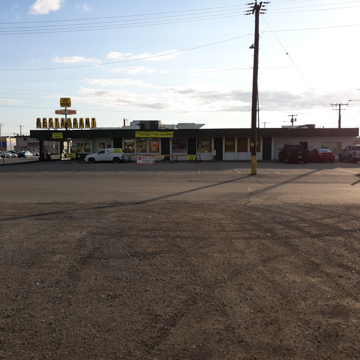Founded in late 1955 by George and Peggy Brown at the corner of East 5th Avenue and Karluk Street on the northeast edge of Anchorage's downtown, the Lucky Wishbone restaurant remains an Anchorage fixture and one of the longest continually operating restaurants in Alaska. Accessible from E. 5th as one enters downtown heading south, the restaurant is easily recognized by its projecting green cantilever metal roof and its plastic yellow signage with black print. A small overhead sign reads "Lucky Wishbone" and ten individual blocks spell out "RESTAURANT" just below. Two additional white signs with red letters proclaim, "Pan Fried Chicken"—the meal most widely associated with the Lucky Wishbone.
The restaurant is not in a particularly pedestrian-friendly part of the city. A small parking lot is on the east side of the building. One may eat in the dining room or drive through the take-and-go window situated at the south end of the restaurant. The dining room is spacious and known for its collection of historic photos illustrating Anchorage's frontier past. The building exterior is primarily composed of concrete blocks, painted white with green trim. The green trim, green booths, and green roof conjure the Irish heritage of the restaurant's original owners, George and Peggy Brown.
George Brown met his future wife, Peggy, during World War II and first traveled the Alcan Highway to Anchorage in 1951 to take advantage of an expanding economy. However, their initial stay in Alaska did not last, and they moved to Tucson, Arizona, where they opened Brown’s Drive Up. After that business failed, the Browns decided to give Alaska another chance and returned soon after. This time they opened a diner-style restaurant that specialized in fried chicken and other American comfort foods. When Lucky Wishbone first opened in 1955, a regular and jumbo hamburger cost 40 cents and 65 cents, respectively. The fried chicken was available in three sizes—junior, mom, and pop that cost 80 cents, $1.30, and $1.80 respectively. Coffee was 10 cents and milkshakes were 35 cents each. First-day sales totaled $80, but by that weekend, the café was packed and earning hundreds of dollars daily.
While the menu has generally remained the same, the Lucky Wishbone was a pioneer in Alaska for adopting an early smoking ban in its dining room in 1990. The Browns had lost friends to lung cancer and viewed it as a bad and unhealthy habit. Also, “I just didn’t want to empty any more damn ashtrays,” said George. It would take Alaska over twenty years to ban smoking in all of its dining establishments.
Although the prices have increased over time, the Lucky Wishbone remains as popular in the current era as it was upon its opening. The most popular menu items are still the fried chicken and milkshakes; though more novel items such as fried gizzards and chicken livers also have a devoted fanbase.
Peggy Brown passed in 2016. When George passed in 2018 at the age of 96, his planned succession took effect, with longtime employees Heidi Heinrich and Carolina Stacey assuming ownership. Said Heinrich in late 2018, “we work very, very hard to try and keep it the same because it means things to people.”
References
“Family Ties and Fried Chicken.” Anchorage Daily News, August 30, 2018.
“Lucky Wishbone advertisement.” Anchorage Daily Times, December 2, 1955, 10.
McKinney, Debra. “Lucky Wishbone Co-Owner Peggy Brown Dead at 87.” Anchorage Daily News, April 19, 2011.




